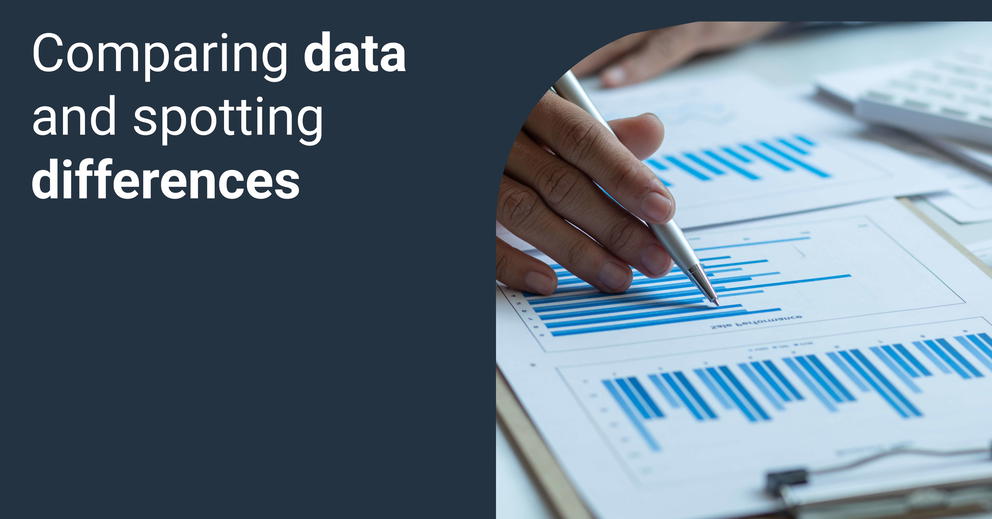Discrete vs. Continuous Data: What Is The Difference?
Sometimes we create data without even realizing it — sending a text message, posting a photo on Instagram or just browsing through various websites. To put a number on it, in 2020, people generated 2.5 quintillions of data every second. Like the many ways to create data, there are plenty of various data types. There are structured and unstructured data. Then there is qualitative and quantitative data. And finally, there are discrete vs. continuous data, which is the fundamentals for every person working with businesses.

Jul 29 2021●7 min read

Learning the difference between discrete and continuous data and the use cases can seem overwhelming. However, data-driven insights are playing an important role in business success. The professionals who understand these unique data types can identify opportunities where data can come in handy. Marketing professionals can leverage this information to improve their strategies and optimize advertising campaigns.
What is numerical data?
Numerical data, also known as quantitative, is a data type expressed in numbers rather than natural language. Numerical data differentiates itself from other number form data types with its ability to carry out arithmetic operations with these numbers.
Quantitative data is split into two types of data: discrete one, which represents countable items. And continuous data, which outlines data measurement. The continuous numerical data is further subdivided into interval and ratio data, known for measuring certain items.
The discrete data fundamentals
Discrete data is a count that involves integers — only a limited number of values is possible. This type of data cannot be subdivided into different parts. Discrete data includes discrete variables that are finite, numeric, countable, and non-negative integers. In many cases, discrete data can be prefixed with “the number of”. For example:
- The number of students who have attended the class;
- The number of customers who have bought different products;
- The number of groceries people are purchasing every day;
This data type is mainly used for simple statistical analysis because it’s easy to summarize and compute. In most of the practices, discrete data is displayed by bar graphs, stem-and-leaf-plot and pie charts.
Continuous data — it’s all about accuracy
Continuous data is considered the complete opposite of discrete data. It’s the type of numerical data that refers to the unspecified number of possible measurements between two presumed points.
The numbers of continuous data are not always clean and integers, as they are usually collected from very precise measurements. Measuring a particular subject is allowing for creating a defined range to collect more data.
Variables in continuous data sets often carry decimal points, with the number stretching out as far as possible. Typically, it changes over time. It can have completely different values at different time intervals, which might not always be whole numbers. Here are some examples:
- The weather temperature;
- The wind speed;
- The weight of the kids;
Continuous data can be measured by using specific tools and displayed in line graphs, skews, histograms.
Discrete vs. continuous data — the comparison
Both data types are important for statistical analysis. However, some major differences need to be noted before drawing any conclusions or making decisions. The key differences are:
- Discrete data is the type of data that has clear spaces between values. Continuous data is data that falls in a constant sequence.
- Discrete data is countable while continuous — measurable.
- To accurately represent discrete data, the bar graph is used. Histogram or line graphs are used to represent continuous data graphically. A diagram of the discrete function shows a distinct point that remains unconnected. While in a continuous function graph, the points are connected with an unbroken line.
- Discrete data contains distinct or separate values. Continuous data includes any value within the preferred range.
What are the examples of discrete and continuous data?
Examples of frequent discrete data include the number of impressions, followers, clicks, video views, conversions, backlinks, and so on. Some common continuous data examples are the click-through rate, domain authority, quality score, video watch time, follower age, conversion rate, etc.
The importance of discrete and continuous data
Both discrete and continuous data are valuable for all sorts of data-driven decisions and it's important to know how to interpret data. Valuable research and insights are made by combining both sets of data. Here are some examples where discrete and continuous data can be used:
- Marketing and advertising. Before engaging in any marketing or advertising campaign, companies need to analyze internal and external factors that may affect the marketing campaigns. In most cases, marketing professionals are using SWOT analysis. A SWOT analysis is a compilation of the business’s strengths, weaknesses, opportunities and threats. The primary objective of this analysis is to help companies develop a full awareness of all the factors involved in making data-driven decisions. In that case, email marketing could be a great option through email marketing automation software.
- Research. Numerical types of data are popular among researchers due to their compatibility with most statistical techniques. Discrete and continuous data helps to ease the research process.
- Fundraising performance. Discrete data like the number of donors, event attendees, or campaign participants helps nonprofits evaluate which fundraising ideas drive the most engagement. Combined with continuous metrics like average donation size, it gives a full picture of campaign performance.
- Population analysis. Using trends analysis, researchers gather the data on various rates in a country or a region for a certain period and predict future populations. This might include birth, death rates, languages popularity, et cetera. Predicting a country's demographics plays a vital role in economics.
- Product development. Product researchers use total unduplicated reach and frequency analysis (TURF) to investigate if a new product or service will have the demand and will be well-received in the target market during the product development stage.
However, the implementation of discrete or continuous data might not always provide accurate results, as there are challenges related to only analyzing numerical data. For example:
- Discrete or continuous data research can be limited in their pursuit of statistical relationships. It can lead to researchers overlooking valuable insights. By focusing solely on numbers, analyst runs into the risk of missing big-picture information that can benefit the business.
- When conducting research, analysts need to develop a hypothesis and set up a model for collecting and analyzing data. Any errors in the setup, bias on the analysts’ part, or execution mistakes can distort the results. Sometimes even coming up with a hypothesis can be subjective, especially if there is a specific question that needs to be answered and proved by not only numerical data.
How to collect and aggregate numerical data
As challenging as the discrete and continuous data might be, it’s the most useful type in statistical analysis. Numerical data allows businesses to make data-driven decisions and look for insights that help power up a business’s growth. The insights made from discrete and continuous data also enable marketers to measure their marketing efforts’ effectiveness and implement better strategies in the future. To protect user data online, people often use VPN malware to avoid tracking.
Whatagraph can come in handy and ease the labor-intensive process of data collection and aggregation. The reporting tool automatically gathers data from different sources and presents it in a visual report. The collected data can be shown in various charts and graphs, including pie charts for discrete data and line graphs for continuous data.
Bottom line
Hence, it’s quite clear that the two types of data are different in the explanations and examples. Discrete data presents a certain number of isolated values. In contrast — continuous data shows any value from a given range.
Understanding the numerical data and the difference between discrete and continuous data might pose a challenge initially. However, after mastering the data, marketing professionals will be able to support their performance insights with actual and accurate data.

WRITTEN BY
Benediktas KazlauskasBenediktas is a detail-oriented writer with a passion for marketing and technology. Using his vast experience in Business Management and Sales, he approaches every blog with the same idea: How to make readers come back for more?